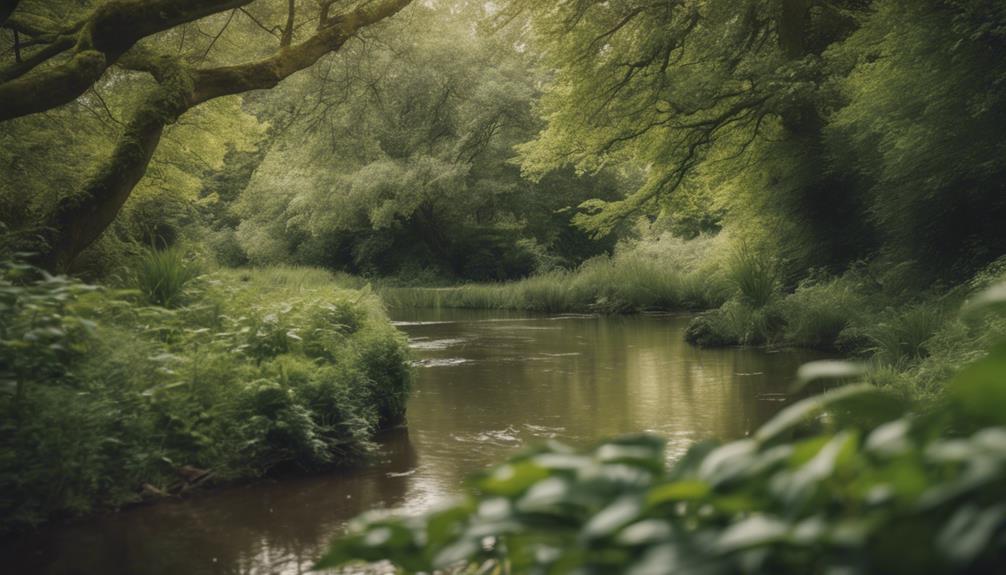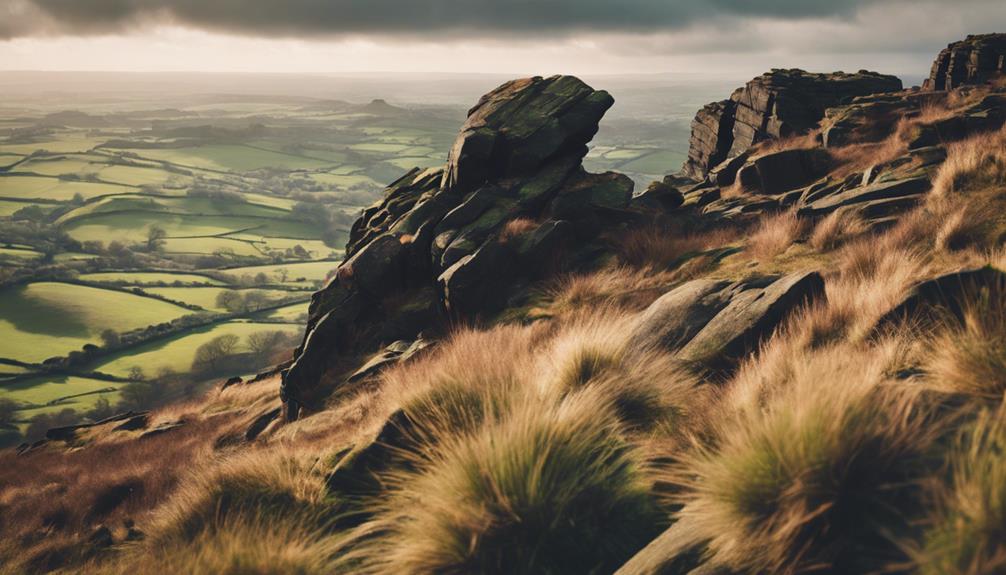Best Birdwatching Spots Near Stoke-on-Trent
Head to Doxey Marshes Nature Reserve, a serene wetland sanctuary in Staffordshire with diverse bird species and ideal for bird migrations. Explore Tittesworth Water, a scenic reservoir near Leek boasting various habitats and special bird sightings. Discover Consall Nature Park, a 70-acre woodland paradise abundant with birds and fantastic for wildlife photography. Uncover Chasewater Country Park's natural beauty, home to a variety of birds showcasing fascinating behaviors. Don't miss The Roaches, a rocky ridge in the Peak District offering unique birdwatching opportunities. Peregrine Falcons and Wood Warblers are just a glimpse of what awaits. More exciting spots to uncover!
Key Takeaways
- Doxey Marshes Nature Reserve offers diverse bird species and great photography opportunities.
- Tittesworth Water, a picturesque reservoir, is a designated birdwatching site with Kingfishers and Grebes.
- Consall Nature Park provides 70 acres of habitats for birdwatching and photography, focusing on conservation.
- Chasewater Country Park has a variety of bird species and key birdwatching times for optimal viewing.
- The Roaches in Peak District National Park offer unique rocky habitats for bird species like Peregrine Falcons.
Doxey Marshes Nature Reserve
Explore the tranquil beauty of Doxey Marshes Nature Reserve for exceptional birdwatching experiences. This wetland oasis in Staffordshire is a haven for bird enthusiasts. As you wander through the reserve's nature trails and footpaths, you'll encounter a diverse range of bird species, from the colorful Kingfishers to the majestic Peregrine Falcons. Conservation efforts at Doxey Marshes have created a thriving ecosystem, making it a prime spot to witness bird migration patterns.
With its unique setting, Doxey Marshes provides ample opportunities for wildlife photography. Capture stunning shots of Willow Tits and other bird species in their natural habitat. The reserve's varied landscapes offer different lighting conditions throughout the day, perfect for honing your wildlife photography techniques. Early morning, late afternoon, dusk, dawn, and mid-morning are the best times to observe the birds in action.
Immerse yourself in the beauty of Doxey Marshes and witness the wonders of nature unfold before your eyes.
Tittesworth Water
Tittesworth Water, a picturesque reservoir nestled near Leek in Staffordshire, offers exceptional birdwatching opportunities for enthusiasts. The reservoir covers around 38 hectares, providing a diverse habitat for various bird species. Birdwatchers have spotted Kingfishers, Great Crested Grebes, and Common Terns in this area, delighting in their graceful movements and vibrant colors. Nature trails and bird hides are strategically positioned for excellent bird observation, allowing visitors to immerse themselves in the tranquil surroundings. Tittesworth Water's designation as a Site of Special Scientific Interest underscores its importance for wildlife, particularly bird populations, highlighting the significance of habitat preservation efforts in the region.
| Bird Species | Sightings Reported | Notable Features |
|---|---|---|
| Kingfishers | Yes | Colorful plumage |
| Great Crested Grebes | Yes | Elegant courtship displays |
| Common Terns | Yes | Aerial acrobatics |
Consall Nature Park

Nestled within Stoke-on-Trent, Consall Nature Park beckons birdwatchers with its 70 acres of enchanting woodland and wetland habitats, teeming with diverse bird species. As you wander through the park's well-maintained nature trails and footpaths, keep your eyes peeled for elusive Kingfishers, charming Willow Tits, and vibrant Redstarts. The park not only offers fantastic bird hideouts for observing these feathered wonders but also provides excellent opportunities for wildlife photography enthusiasts to capture memorable moments in nature.
Consall Nature Park isn't just a picturesque site for birdwatching; it's also actively involved in conservation efforts and species protection. By visiting the park, you contribute to the preservation of these avian treasures and their habitats. Additionally, with convenient parking options available for visitors, exploring the park's natural beauty and discovering its unique bird species has never been easier.
Chasewater Country Park
Located near Stoke-on-Trent in Staffordshire, Chasewater Country Park offers birdwatchers a diverse range of opportunities to observe unique bird species in their natural habitats. The park's large reservoir, surrounded by woodlands, meadows, and wetland areas, provides an ideal setting for birdwatching enthusiasts. Bird behavior at Chasewater is fascinating, with Kingfishers darting over the water, Peregrine Falcons soaring in the skies, and Willow Tits chirping in the trees. Conservation efforts at the park have helped maintain a healthy ecosystem for these birds to thrive.
When birdwatching at Chasewater, consider visiting during early morning, late afternoon, dusk, dawn, and mid-morning for the best chances of spotting these feathered friends. Remember to bring essential gear like binoculars, a bird guidebook, a camera for capturing memorable moments, comfortable footwear for exploring the park's various terrains, and water and snacks to stay energized during your birdwatching adventure. Chasewater Country Park awaits your exploration and discovery of its avian wonders.
The Roaches

For vital birdwatching opportunities, head to The Roaches, a prominent rocky ridge in the Peak District National Park. The Roaches is renowned for its stunning rock formations that not only provide a picturesque backdrop but also create ideal habitats for a diverse range of bird species.
As you explore this area, you'll be captivated by the unique photography opportunities it presents, allowing you to capture beautiful moments of birds in their natural surroundings.
Conservation efforts at The Roaches have played an essential role in maintaining the delicate balance of bird population dynamics in the region. Birdwatchers can witness a variety of species, including Peregrine Falcons, Ravens, and Meadow Pipits, thanks to the preservation of habitats like heathland, woodland, and rocky outcrops.
The conservation initiatives have guaranteed that both resident and migratory birds thrive in this environment, making The Roaches a rewarding destination for birdwatching enthusiasts seeking to connect with nature.
Kingfishers
Venture into the tranquil waterside habitats near Stoke-on-Trent, and you may be fortunate enough to catch a glimpse of the vibrant and agile kingfishers. These small, colorful birds with iridescent plumage are a sight to behold as they flit around rivers, lakes, and ponds with grace and speed. Here are some fascinating facts about kingfishers:
- Distinctive Appearance: Kingfishers sport bright blue and orange plumage, a long sharp bill, and short legs that aid them in their fishing expeditions.
- Skilled Hunters: These stunning birds are adept at diving into the water to catch fish, their main source of food, showcasing remarkable precision and agility.
- Conservation: Kingfishers are subject to conservation efforts due to habitat loss, pollution, and human disturbances affecting their populations.
- Breeding Habits: Kingfishers typically nest in burrows dug into the riverbank, where they lay their eggs and raise their young in a cozy and safe environment.
Observing these beautiful birds in action isn't only captivating but also offers insight into the importance of kingfisher conservation and their intriguing breeding habits.
Peregrine Falcons

Peregrine Falcons exhibit fascinating nesting behaviors, often choosing high cliffs or tall buildings as their nesting sites.
Their hunting techniques are a sight to behold, relying on their remarkable speed and agility to catch prey on the wing.
Observing these majestic birds in action can provide valuable insights into their survival strategies and natural behaviors.
Nesting Behaviors
Often choosing cliff ledges, tall buildings, or bridges as nesting sites, Peregrine Falcons are known for their impressive nesting behaviors. When observing these majestic birds in their natural habitat, you may notice the following:
- Incredible Breeding Fidelity: Peregrine Falcons exhibit remarkable loyalty to their nesting sites, returning year after year to the same location to breed.
- Fascinating Courtship Displays: These birds engage in captivating courtship rituals, which include high-speed aerial chases and vocalizations to establish and maintain pair bonds.
- Clutch Size: The female Peregrine Falcon typically lays 3-4 eggs per clutch, initiating an incubation period of around 29-32 days before hatching.
- Dependent Eyases: Young Peregrine Falcons, referred to as eyases, rely on their parents for food and care until they fledge, usually around 6 weeks after hatching.
Hunting Techniques
Utilizing their remarkable stooping technique, Peregrine Falcons showcase unparalleled hunting prowess, reaching speeds of over 240 mph to capture prey mid-air. These birds excel in speedy stooping, where they dive from great heights with precision and speed.
Their aerial acrobatics are a sight to behold as they maneuver effortlessly through the sky to surprise their prey. Peregrine Falcons primarily target other birds, using their agility and sharp talons to catch them in flight.
Specially adapted nostrils protect their lungs during these high-speed dives, enabling them to maintain their hunting efficiency. With sharp talons and a strong beak, Peregrine Falcons swiftly grasp and dispatch their prey, demonstrating their expertise in the art of mid-air hunting.
Wood Warblers
Wood Warblers, with their vibrant yellow plumage and distinctive high-pitched warbling song, are small migratory songbirds that breed in deciduous woodlands across Europe, including Staffordshire. When it comes to these charming birds, here are some fascinating facts to help you appreciate their beauty and behavior:
- Breeding Habits: Wood Warblers are known for their territorial nature during the breeding season. Males defend their nesting territories vigorously, performing elaborate song displays to attract females.
- Vocalizations: Their melodic and high-pitched warbling song is a delight to listen to in the woodlands. Wood Warblers use their vocalizations not just for attracting mates but also for defending their territories.
- Foraging Behavior: These birds primarily feed on insects like caterpillars, beetles, and spiders. They're skilled at foraging in the tree canopy, making them a challenge to spot but rewarding to observe.
- Plumage: Male Wood Warblers boast vibrant yellow plumage with a greenish back, while females exhibit a duller coloration. This distinct coloring helps them blend into their leafy habitats.
Conclusion
To sum up, Stoke-on-Trent offers a variety of excellent birdwatching spots for nature enthusiasts to explore.
From the serene Doxey Marshes Nature Reserve to the picturesque Tittesworth Water, there are plenty of opportunities to observe a diverse range of bird species in their natural habitat.
Whether you're hoping to catch a glimpse of Kingfishers darting through the water or Peregrine Falcons soaring overhead, these locations provide the perfect setting for a rewarding birdwatching experience.

